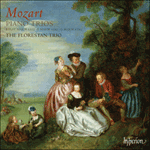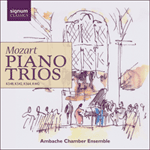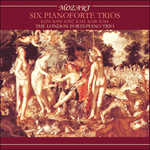
Welcome to Hyperion Records, a British classical label devoted to presenting high-quality recordings of music of all styles and from all periods from the twelfth century to the twenty-first.
Hyperion offers both CDs, and downloads in a number of formats. The site is also available in several languages.
Please use the dropdown buttons to set your preferred options, or use the checkbox to accept the defaults.
As in the preceding Trio in B flat, the piano-writing is at times almost like that of a concerto. But in other ways the character of this trio is quite different. The key of E major is highly unusual for Mozart, and the first movement in particular is full of harmonic twists and surprises. The opening theme on the piano seems uncertain whether it is joyful or melancholy, drooping chromatically downwards in its second bar. Rushing scales as the strings join in seem to tilt the balance away from melancholy, and the music proceeds serenely on its way, until one of the piano’s rising scales unexpectedly hits a B sharp, abruptly generating a modulation to bring us to B major for the second theme. As this theme draws to a close, we suddenly find ourselves in G major and then G minor—very remote from E major. But Mozart equally quickly recovers to end the first section in B major, rounding it off with an extended version of the chromatically drooping second bar. Characteristically, Mozart follows with a development based not on the most prominent material, but on an apparently insignificant falling interval from the middle of the first theme, followed by a new phrase with a turn and a rising scale. The three instruments answer in fugal style, continuing in genial conversation until the piano suddenly bursts into a passage of flamboyant concerto arpeggios. Equally abruptly this comes to a halt, and we are back at the reprise of the opening theme.
The second movement is a graceful Andante, with dotted rhythms and pointed off-beat phrasing suggesting the poise of a formal dance. Again, sudden harmonic surprises give an occasional dark hint of what lies below the surface. Most poignant is the middle section in the minor, with the violin answered by questioning phrases in the bass of the piano.
Mozart had two attempts at writing the finale for this trio. He wrote more than sixty bars of a first version before abandoning it: just as he was embarking on a fugato passage, he decided to start all over again. The new theme which he then wrote is, as Alfred Einstein puts it, ‘almost childlike’. It owes part of its character to the fact that, as the piano begins the melody, the accompanying left hand avoids playing the keynote, E, until the strings come in. This has the effect of making the theme seem to float in the air, unsupported. The finale echoes elements from the first movement: a second theme begins with a falling chromatic scale, and in later episodes the piano breaks into brilliant runs and arpeggios, answered on one occasion by a dashing display from the violin. But the simple main theme seems quite unaffected by all this; and as the movement draws to a close, Mozart presents us with not so much a climax as a distillation of the mood of the whole piece. And this impression is reinforced by the final bars, where each instrument reiterates the little turn and rising scale that had figured prominently in the central section of the first movement.
from notes by Robert Philip © 2006
Comme dans le Trio en si bémol précédent, l’écriture pianistique rappelle parfois celle d’un concerto. Mais, hormis ce point, ce nouveau trio est d’une toute autre trempe. La tonalité de mi majeur est fort inhabituelle chez Mozart et le premier mouvement, notamment, regorge de revirements harmoniques et de surprises. Le thème d’ouverture, au piano, qui paraît hésiter entre la joie et la mélancolie, descend chromatiquement à la deuxième mesure. Des gammes précipitées, à l’entrée des cordes, semblent chasser la mélancolie et la musique poursuit sereinement son chemin jusqu’à ce qu’une des gammes ascendantes du piano frappe un si dièse inattendu, engendrant une brusque modulation qui nous ramène à si majeur pour le second thème. Lorsque ce dernier touche à sa fin, on se retrouve soudain en sol majeur, puis en sol mineur—très loin de mi majeur. Mais Mozart se ressaisit tout aussi vite et clôt la première section en si majeur, avec une version prolongée de la deuxième mesure abaissée chromatiquement. Comme à son habitude, il poursuit par un développement fondé non sur le matériau le plus saillant, mais sur un intervalle descendant, en apparence insignifiant, tiré du milieu du premier thème et suivi d’une nouvelle phrase avec un double et une gamme ascendante. Les trois instruments se répondent en style fugué, poursuivant une aimable conversation jusqu’à ce que le piano explose soudain en de flamboyants arpèges de concerto, qui s’arrêtent tout aussi brusquement pour nous ramener à la reprise du thème d’ouverture.
Le second mouvement est un gracieux Andante avec des rythmes pointés et un insistant phrasé anacroustique suggérant le calme d’une danse solennelle. Là encore, de soudaines surprises harmoniques offrent un sombre aperçu de ce qui se cache sous la surface. Moment le plus poignant, la section centrale, en mineur, voit la basse du piano répondre au violon par des phrases inquisitrices.
Mozart s’y reprit à deux fois pour écrire le finale de ce trio: il avait déjà composé soixante mesures d’une première version et s’apprêtait à entamer un passage fugato quand il décida de tout recommencer. Le nouveau thème qu’il composa alors est, pour reprendre Alfred Einstein, «presque enfantin». Son caractère tient en partie au fait que, lorsque le piano commence la mélodie, la main gauche accompagnante évite de jouer la fondamentale (mi) avant l’entrée des cordes. D’où ce thème qui semble flotter, tout seul, dans l’air. Le mouvement renvoie à des éléments du premier mouvement: un second thème s’ouvre sur une gamme chromatique descendante et, dans les épisodes suivants, le piano entame de brillants passages rapides et des arpèges, auxquels répond, une fois, une éblouissante démonstration de violon. Mais le thème principal simple ne semble en rien affecté par tout cela; et, lorsque le mouvement touche à sa fin, Mozart ne nous offre pas tant un apogée qu’une distillation du climat d’ensemble de la pièce. Une impression que renforcent les dernières mesures, où chaque instrument réitère le petit double et la gamme ascendante qui avaient marqué la section centrale du premier mouvement.
extrait des notes rédigées par Robert Philip © 2006
Français: Hypérion
Wie schon in dem vorhergegangenen Trio in B-Dur ähnelt der Klavierpart mitunter fast dem eines Klavierkonzerts. Doch in anderer Hinsicht unterscheidet sich der Charakter dieses Trios sehr von dem seines Vorgängers. E-Dur ist für Mozart eine äußerst ungewöhnliche Tonart, und besonders der erste Satz ist voller harmonischer Wendungen und Überraschungen. Das Anfangsthema im Klavier schwankt zwischen Freude und Melancholie, wobei es bereits im zweiten Takt chromatisch abfällt. Der Einsatz der Streicher mit ihren eilenden Tonleitern scheint das Gleichgewicht zu Ungunsten der Melancholie zu kippen, und die Musik nimmt gelassen ihren Lauf, bis eine der aufwärtsgehenden Tonleitern im Klavier unerwartet auf einem His landet, und so eine jähe Modulation zum H-Dur des zweiten Themas herbeiführt. Wenn sich dieses Thema seinem Ende zuneigt, befinden wir uns plötzlich in G-Dur und dann g-Moll—weit entfernt von E-Dur. Genauso schnell aber bringt Mozart alles wieder ins Lot und beendet den ersten Teil in H-Dur und mit einer abschließenden Erweiterung des chromatisch sinkenden zweiten Taktes. Es folgt eine Durchführung, die—typisch für Mozart—nicht etwa auf dem vordergründigsten Material basiert, sondern auf einem scheinbar unbedeutenden fallenden Intervall aus der Mitte des ersten Themas, dem eine neue Phrase mit Doppelschlag und aufwärtsgehender Tonleiter folgt. Die drei Instrumente antworten im fugierten Stil und führen ein freundliches Gespräch miteinander, bis das Klavier plötzlich in eine Passage extravaganter konzertartiger Arpeggien ausbricht. Genauso plötzlich endet sie auch wieder, und die Musik kehrt zur Reprise des Anfangsthemas zurück.
Beim zweiten Satz handelt es sich um ein anmutiges Andante mit punktierten Rhythmen und pointierten synkopierten Phrasierungen, welche die Grazie eines formellen Tanzes suggerieren. Abermals liefern plötzliche harmonische Überraschungen gelegentlich einen dunklen Hinweis darauf, was noch unter der Oberfläche schlummert. Am ergreifendsten ist der Mittelteil in Moll, in dem fragende Phrasen im Baß des Klaviers auf die Geige antworten.
Mozart unternahm zwei Anläufe, um das Finale für dieses Trio zu schreiben. Er komponierte mehr als sechzig Takte einer ersten Version, bevor er sie verwarf. Gerade als er die Arbeit an einer fugierten Passage anging, beschloß er, noch einmal vor vorne zu beginnen. Das neue Thema, das er dann schuf, ist, in den Wortern Alfred Einsteins, „fast kindlich“. Sein Charakter liegt zum Teil in dem Umstand begründet, daß die begleitende linke Hand beim Beginn der Melodie im Klavier den Grundton E gänzlich meidet, bis die Streicher einsetzen. Dadurch scheint das Thema frei in der Luft zu schweben. Es klingen Elemente aus dem ersten Satz wider: ein zweites Thema etwa beginnt mit einer fallenden chromatischen Tonleiter, und in späteren Episoden bricht das Klavier in brillante Läufe und Arpeggien aus, welche auch einmal durch eine schneidige Vorführung der Violine erwidert werden. Doch das schlichte Hauptthema scheint all dies nicht weiter zu berühren, und während der Satz seinem Ende zugeht, präsentiert Mozart nicht so sehr einen Höhepunkt als eher ein Destillat aus der Stimmung des ganzen Stückes. Auch die letzten Takte, in denen jedes der Instrumente den Doppelschlag und die aufwärtsgehende Tonleiter wiederholt, die im Mittelteil des ersten Satzes so vordergründig gewesen waren, verstärken diesen Eindruck.
aus dem Begleittext von Robert Philip © 2006
Deutsch: Bettina Reinke-Welsh
 Mozart: Piano Trios K502, 542 & 564 Mozart: Piano Trios K502, 542 & 564‘These are beautifully judged performances, generally fleeter of foot, airier of texture and more intimate in tone with an ideal balance between the i ... ‘Superb execution … another feather in the Florestan Trio's cap’ (International Record Review)» More |
 Mozart: Piano Trios K548, 542 & 564 Mozart: Piano Trios K548, 542 & 564Teasing, flirtatious, tender, elusive, anguished, charming and magical are all words used by performer and classical specialist, Diana Ambache, to describe these three Mozart piano trios, written in his last three year.» More |
 Mozart: Six Piano Trios Mozart: Six Piano Trios |

